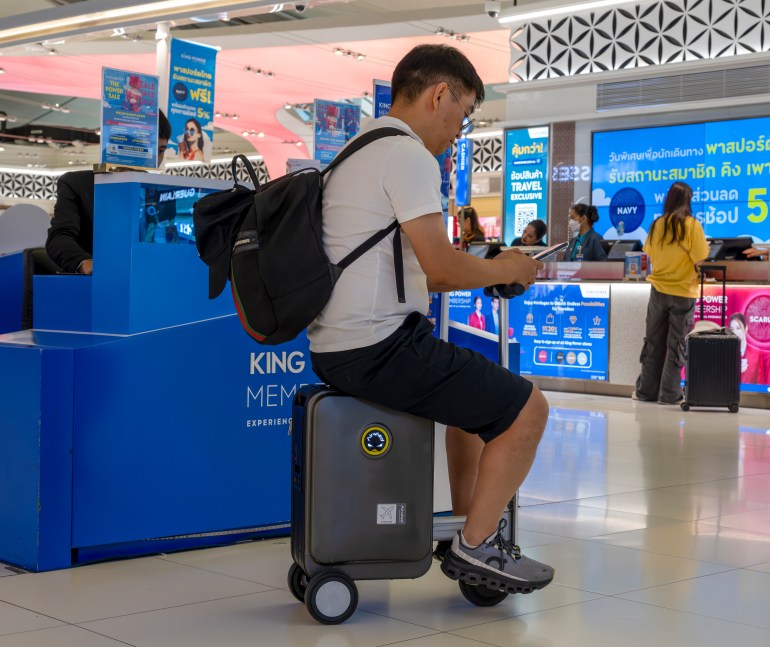EXPLAINER
A growing number of airports are imposing restrictions on these electric suitcases over safety concerns.
Rideable motorised suitcases, which emerged almost 10 years ago as something futuristically novel as well as functional, have increasingly become popular among travellers.
But the rideable suitcase craze is getting pushback in some Japanese airports because of safety concerns and due to some foreign visitors using them illegally on public roads.
So what do we know about rideable suitcases, and why are there growing restrictions on their use?

What’s a rideable suitcase, and how big is global ride-on luggage market?
Rideable suitcases are like electric scooters and in many cases are powered by lithium-ion batteries that help in traversing short distances, especially at airports and supermarkets.
Many of these rideable suitcases can reach maximum speeds of 13 kilometres per hour (8 miles per hour). That’s the equivalent of the average running speed for a moderately fit jogger.
The first rideable suitcase was produced by a company called Modobag in 2016.
The global ride-on luggage market was valued at $182m in 2021 and is projected to reach $304m by 2031, according to Applied Market Research, a market research company.
Why is Japan cracking down on rideable suitcases?
This is mostly due to the increased popularity of rideable suitcases, and with this growth comes challenges of where these suitcases can be used and how.
Tokyo’s Haneda Airport in February banned the use of rideable suitcases in terminals to avoid collisions with other passengers, according to the Kyodo News agency. Narita International Airport, the second largest in the Japanese capital, issued an advisory asking passengers in its terminals to monitor their surroundings due to the increased use of rideable suitcases. This advisory was due to complaints of these suitcases causing disruptions.
Rideable suitcases seem to have become a public safety issue beyond the airports. Japan has enacted laws that require riders of motorised suitcases to have a driver’s licence to ride outside airports under the Road Traffic Act.
In June, a Chinese woman became the first person to be fined for riding a suitcase on a sidewalk in Osaka without a licence. The woman, a student in Japan, was seen by police riding a three-wheeled electric suitcase on a sidewalk in March.
This month, a boy from Indonesia was stopped by authorities for riding a suitcase through the busy Dotonbori shopping area in Osaka, according to Kyodo News. His family was unaware that a driving licence was required.
Japanese traffic laws classify these rideable suitcases as “motorised bicycles”, which includes mini-motorcycles powered by engines of 50cc or less. By law, they must be registered and equipped with a rear-view mirror and turn signals. Additionally, drivers are obligated to wear a helmet and have liability insurance.
Even electric scooters have posed a challenge for Japan.
After restrictions were loosened up in July 2023, traffic violations increased fourfold in six months, according to the National Police Agency.
What are other airports doing about rideable suitcases?
Restrictions vary by airport and country. In most United States airports, rideable suitcases that are compliant with the rules of the Transportation Security Administration (TSA) and Federal Aviation Administration(FAA) are allowed in terminals with some restrictions for certain airlines.
Since 2013, the FAA prohibits extra lithium batteries from being stored in an aircraft’s cargo unit. If passengers want to check rideable suitcases, they must first remove their lithium battery packs and carry them on the plane with them.
Singapore Changi Airport has banned the suitcases entirely.
In airports across Canada, small lithium battery-powered vehicles are not allowed in checked baggage or carry-on baggage due to safety concerns related to the lithium batteries.
How rideable suitcases are regulated depends on several factors. Whether they are classified as a public motorised vehicle often impacts whether users need a licence. Other restrictions include how fast you can use a rideable suitcase indoors or outdoors and whether you are required to wear a helmet.
What else have airports regulated in the past?
Although it’s been almost 25 years since smoking has been banned on airplanes, smoking indoors is still allowed in airports with designated smoking areas and lounges.
One major restriction is the liquid limit for carry-on luggage implemented in 2006 after London’s Metropolitan Police uncovered a plot to use liquid explosives to blow up a plane on a transatlantic flight.
